Catalogue No. 4 (E-List) - Recent Acquisitions (September 2019)
How to order
Email: underthehillbooks@gmail.com
Terms of payment
All major credit cards and Paypal accepted. Please inquire if further details are needed. Items may be returned for any reason, upon notification by email, within seven days of receipt (return shipping is the responsibility of the customer). Libraries and institutions may apply for deferred billing.
Terms of shipping
Postage is additional, and items can be shipped via USPS or UPS.

1) Chapter Thirteen of the First Epistle to the Corinthians Written by Paul the Apostle. Minneapolis, MN: Mary Moulton Cheney, 1903. Limited to 500 copies, of which this is #300. Signed by Cheney on the limitation page. Printed on thick Stratford handmade paper by Hahn & Harmon and bound in cloth by A.J. Dahl & Co. Tan cloth with design on front cover in blue, green and gilt of doves, cross, and grapevines on front cover. Design printed in blue on back cover. Stunning arts & crafts lettering and designs by Cheney on each page, all of which have been colored by hand (presumably by her, as well). 14 unnumbered pages. Measures approx. 5 x 9.5". Edgewear to cloth, and light stains to covers. Some browning and spots to pages.
Along with May Smith, Moulton Cheney was one half of the Chemith Press in Minneapolis, which was also producing volumes around this time. The Chemith Press was the first American private press of the arts & crafts period–and is believed to be one of two total–that was run by women (The Origins of Graphic Design in America, 1870-1920, Raffel & Thomson, 1997). Moulton Cheney is a highly regarded figure in the arts & crafts movement in Minnesota, and “seems to have served as founder, leader, or both, for almost every early arts organization in Minneapolis, as well as the Minnesota State Art Society” (Wikipedia).
Only six library holdings outside of Minnesota (WorldCat).
SOLD
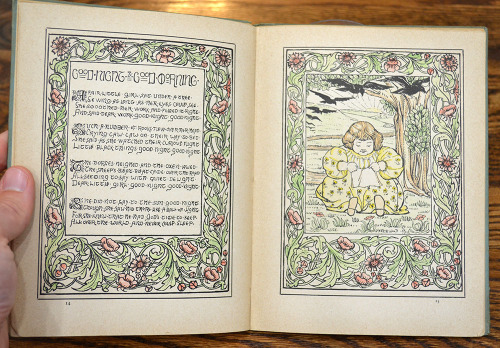
2) Edwards, M[ary Ellen]. Pictorial Rhymes & Verses. London: Society for Promoting Christian Knowledge, [1906]. With drawings by M. Edwards. Beautiful illustrations on nearly every page, all of which have been delicately hand-colored, several featuring charming arts & crafts-influenced borders. Paper-covered boards with red lettering and decoration to front cover. Measures approx. 6.5" x 8.25". Some edgewear and rubbing to covers. Pages lightly browned.
“Mary Ellen Edwards ( 9 November 1838 – 22 December 1934), also known as MEE, was an English artist who contributed to many Victorian newspapers and journals, as well being a prolific illustrator of children’s books. … Outside of her nearly-annual submissions to the Royal Academy, she exhibited four works at the Royal Society of British Artists, one work at the Royal Scottish Academy, eight works at the Royal Glasgow Institute, two works at the British Institution, and nine works at the Society of Women Artists. She contributed to exhibits at the Dudley Gallery in both watercolor and in black and white while her work was also exhibited in galleries in France” (Wikipedia).
According to WorldCat, only a single holding within the United States.
SOLD
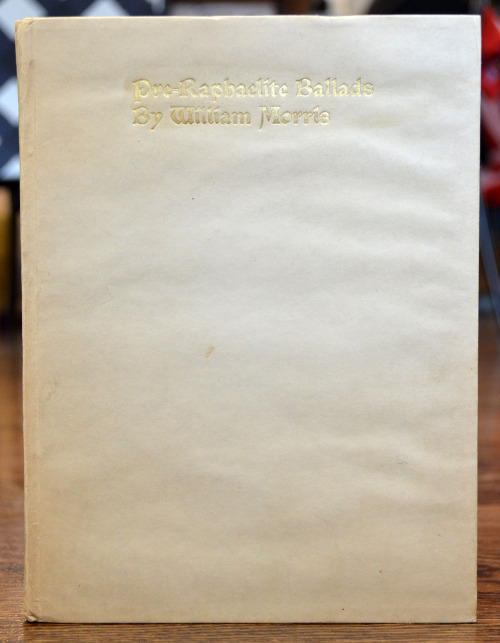
3) Morris, William. Pre-Raphaelite Ballads. New York: A. Wessels, 1900. Designed and partly printed by Clarke Conwell at the Elston Press. Limited to 250 numbered large paper copies on Imperial Japanese vellum, of which this is #214. Printed with red initials and illustrated with black & white full-page decorations by H.M. O'Kane. Full japan vellum-covered boards with gilt lettering to front cover and boards. Measures approx. 6.5" x 8.5". Very slight browning to covers and a bit of rubbing to spine. A beautiful copy.
“The ballads have red initial letters and are embellished by beautiful symbolical borders in black and white: the text is printed direct from a new font of type [ATF Satanick]” (Publishers Weekly).
“…O'Kane is to be congratulated that [her] work has a quickly apparent charm, and that amid a multitude of pitfalls [she] has succeeded in giving Morris’s ballads a suitable setting, for the first and last thing that strikes the reader…is an atmosphere of fitness” (The New York Times Saturday Book Review).
SOLD
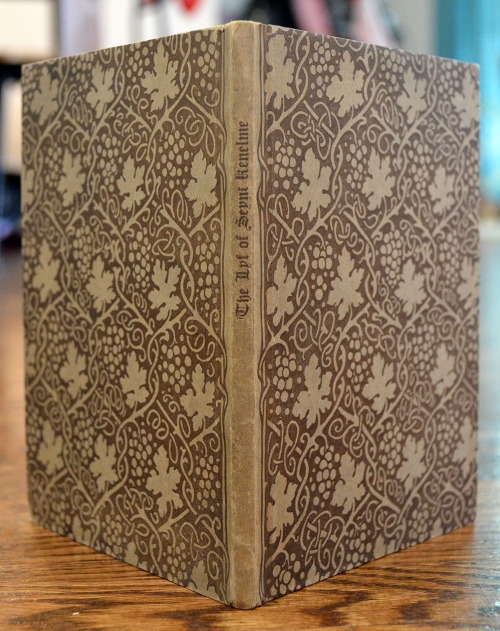
4) The Lyf of Seynt Kenelme, kynge and martir: from Caxton’s Golden Legend, with a note on the origin of the text. Hingham, MA: Printed by Fred and Bertha Goudy at the Village Press, 1905. Limited to 160 copies. Two drawings taken from The Quest. Paper covered boards with a pattern designed by Goudy. Measures approx. 5" x 6.5". Slight rubbing to boards. An excellent example of this rarely seen Village Press title.
“The first book utilizing a type other than Village. The Quest was a little magazine hand-printed by the Birmingham Guild of Handicraft, for whom Mr. D.B. Updike was American representative” (Cary).
SOLD

5) Alighieri, Dante. The Divine Comedy of Dante Alighieri. New York: Bruce Rogers and The Press of A. Colish, 1955. Limited to 300 copies, of which this is #117. The prose translation by Charles Eliot Norton. Thirty double page and 7 single page illustrations from designs by Botticelli. Printed on Fabriano Mills rag paper, bearing a BR & AC watermark. Original full brick red morocco decoratively stamped with a design of BR’s thistle paired with a Florentine lily. Spine lettered in gilt. Top edge gilt, others uncut. In original slipcase, and prospectus loosely inserted. Measures approx. 10" x 14.25". A near-perfect copy of the book. Some light wear to jacket and slipcase.
From an obituary of Rogers in 1957: “His tasks through recent years included completion of a project on which he had worked for 46 years. It is a large format edition of The Divine Comedy of Dante Alighieri, printed in his Centaur type and reproducing his tracings of Botticelli silverpoint drawings that appeared in the Divina Comedia (circa 1480)” (Inland Printer).
From the prospectus: “In describing the project to Mr. Colish, B R writes: ’…this will be a very important book–not so big as the Bible but more decorative. If it is ever finished it will be the most important book of my life and naturally I’d like to have it done at your press.’"
SOLD

6) [Pepler, H.D.C.] Christmas Gifts. Ditchling: St. Dominic’s Press, 1929. A small pamphlet (two leaves, stringbound), with a lovely Eric Gill woodcut of Madonna and child to the front cover. Measures approx. 4” x 5". A touch of browning to edges.
SOLD
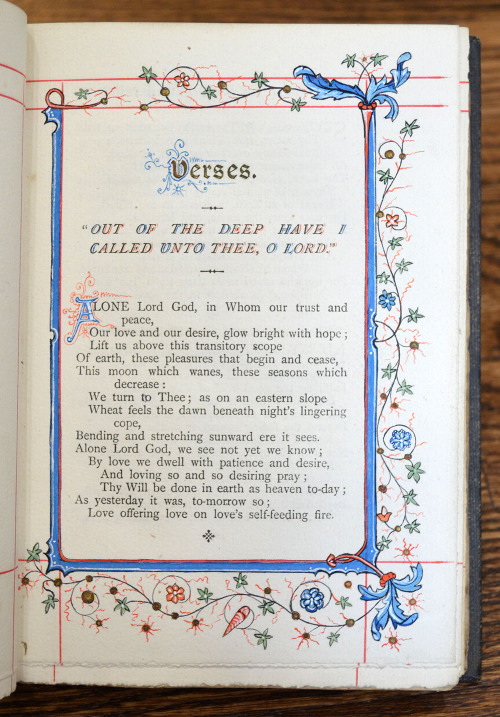
7) Rossetti, Christina G. Verses. London: Society for Promoting Christian Knowledge, 1904. Text printed within red ruled borders. Illuminated in the medieval style, in bold greens, reds, blues, and gold–featuring twenty-one initials, five borders, and two tailpieces. A truly impressive example of turn of the century illumination. Inscription on the ffep: “Annie from William”. Original dark blue cloth stamped in gilt, top edge gilt, uncut, beveled edges. 236 pages. Measures 5" x 7". Some fading and staining to blue cloth.
SOLD
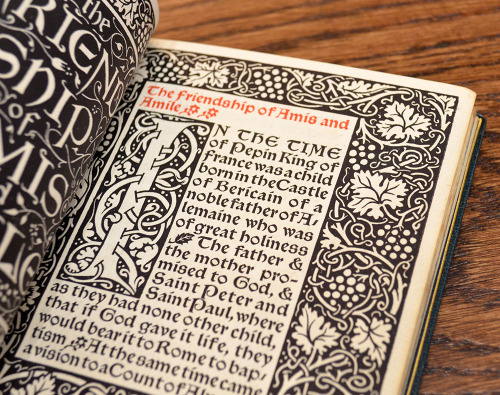
8) Morris, William (translator). Of the Friendship of Amis and Amile. Hammersmith: Kelmscott Press, 1894. One of 500 copies printed on paper by the Kelmscott Press, with wood-cut title page, first page, and initials. Printed in black and red Chaucer type with three-, seven-, and thirteen-line initials. Bound in full blue morocco by Henry T. Wood (of the Wood bindery), with two bands to spine and title in gilt between them. Gilt ruled turn-ins with light blue & brown marbled endpapers. Top edge gilt. Original blue paper covers bound in at rear. Housed in a blue cloth and synthetic leather clamshell case, with paper label to spine. A few very minor spots of wear to the edges, and offsetting to endpapers. Spine very slightly browned.
This “beautiful little book” was translated by Morris from the Bibliotheca Elzeviriana, and “was translated in one day and a quarter, it was very easy…” (Mackail).
SOLD
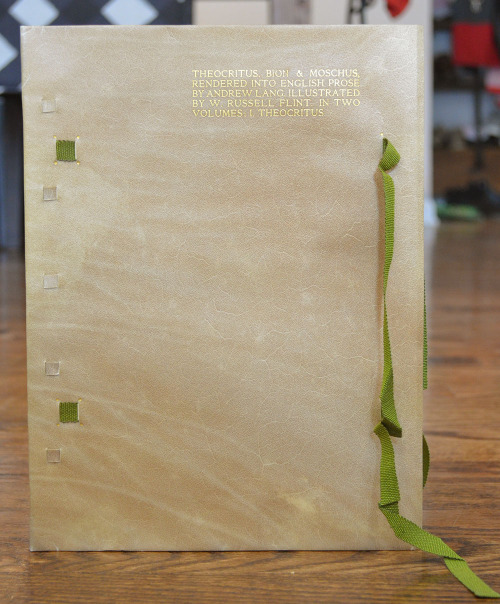
9) (Rendered into English Prose by Andrew Lang). The Idylls of Theocritus & The Idylls of Bion & Moschus. 2 volumes. London: The Medici Society, 1922. Of 12 copies printed on vellum, this is #10. Twenty mounted color plates bound in at rear (fourteen in volume 1, six in volume 2), after watercolor drawings by W. Russell Flint. Tissue guards printed in red. Title-pages printed in black and green, with lettering designed by Edith M. Engall and title page ornament by W. Russell Flint. Bound in full limp vellum with green silk ties, and both volumes include their original dust jackets. Measures 8" x 10.5". Tanning to vellum covers. Some minor natural browning to a few leaves of vellum. Dust jackets worn at top edges and spines faded. A beautiful set.
SOLD
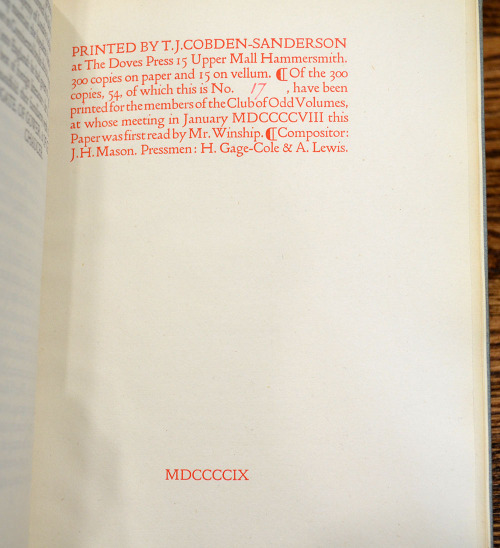
10) Winship, George Parker. William Caxton. A Paper Read at a Meeting of the Club of Odd Volumes in Boston Massachusetts U.S.A. in January MDCCCCVIII by George Parker Winship. Hammersmith: Doves Press, 1909. This is copy #17 of 54 printed for members of the COV, from a total edition of 300 copies on paper. Bound in vellum-backed blue paper over boards, with the Club of Odd Volumes seal gilt-stamped to upper cover. Slip reading “Compliments of the Club of Odd Volumes” bound in at front. Some browning to edges of paper covers and at spine.
SOLD
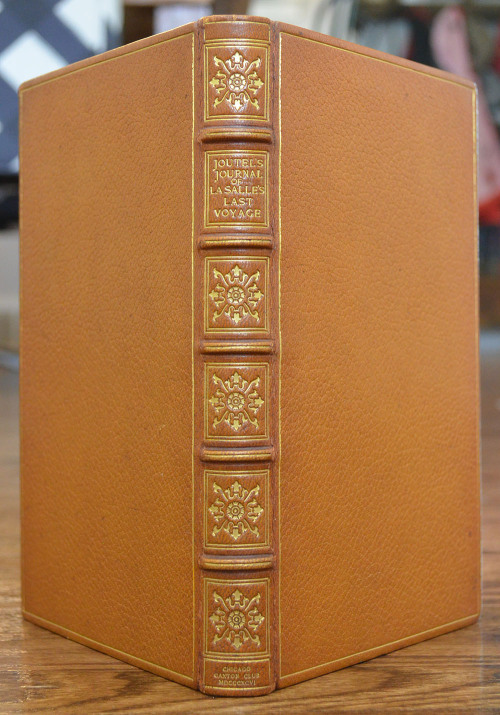
11) Joutel, [Henri]; Anderson, Melville B. (editor). Joutel’s Journal of La Salle’s Last Voyage. Chicago: Caxton Club, 1896. One of 3 copies printed on Japan vellum. “A reprint (page for page and line for line) of the first English translation, London, 1714; with the Map of the original French edition Paris, 1713, in facsimile; and Notes by Melville B. Anderson.“ Fold-out map bound in opposite the original title page. Bound in full medium brown morocco by the Club Bindery in 1898, with added stamp alongside the bindery signature: “for James W. Ellsworth”. Gilt ruled covers with elaborate spine decoration and title to second compartment. Decorated turn-ins with Ellsworth’s bookplate on front pastedown. Measures approx. 6.25” x 9.25". Light rubbing to edges and spots to covers; and small closed cracks (approx. 1.5") to the top and bottom of the front hinge, but still quite sound.
“Of the three copies on Japanese vellum, one was reserved for the Club archives, and two were sold at auction at the annual meeting in February 1897 to James W. Ellsworth and George S. Payson for fifty and forty-five dollars, respectively. (The practice of printing and auctioning unbound vellum copies was discontinued after 1917.”
“Wright Howes, eminent authority on Americana, called [Joutel’s Journal…] the ‘most reliable eye-witness account of LaSalle’s two-years wanderings in Texas. The map, based on LaSalle’s Mississippi explorations, was the first accurate delineation of that river’” (Piehl).
SOLD
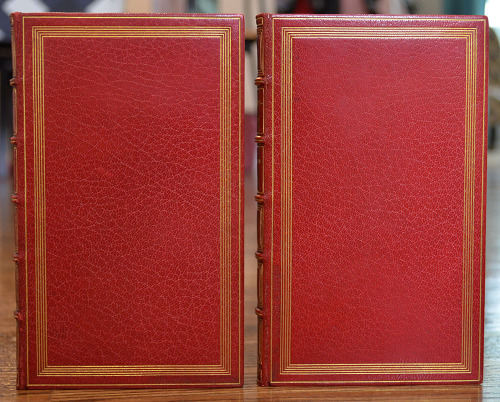
12) Derby, George Horatio; Cheney, John Vance (editor). Phoenixiana. 2 volumes. Chicago: Caxton Club, 1897. One of 3 copies printed on Japan vellum. Illustrated with frontispieces in each volume and numerous color and B&W plates of military figures, including one fold-out plate, all by the author. Measures approx. 4.25" x 7". Bound in full scarlet red morocco by the Club Bindery in 1901, with six gilt rules to each cover. Title and volume to second and third compartments of spine, three gilt rules to the other compartments. Four gilt rules to the turn-ins, and the small bookplate of collector Abel E. Berland to the front pastedown of each volume. Light rubbing to edges.
“Often called the ‘father of American humor,’ Derby was popular around the mid-nineteenth century. The Publications Committee secured from his widow a series of unpublished original sketches that were edited by Caxtonian John Vance Cheney. This book initiated a tradition of publishing original works whenever possible” (Piehl).
SOLD

13) Cheney, John Vance (editor). The Caxton Club Scrap-Book: Early English Verses, 1250-1650. Chicago: Caxton Club, 1904. One of 3 copies printed on Japan vellum. Bound in full reddish brown morocco by Riviere & Son, with gilt lettering to spine and elaborate turn-ins. Measures approx. 6.25" x 9". Fading to spine.
[The Caxton Club Scrap-Book] contained fragments of English verse from the thirteenth to the seventeenth centuries that were chosen and collocated by Caxtonian John Vance Cheney. … While the collection contained a few complete poems, the “scraps” of verse contained, according to President Merryweather, ‘a few lines of description, a metaphor, a fancy, whatever in itself has poetic value’“ (Piehl).
SOLD
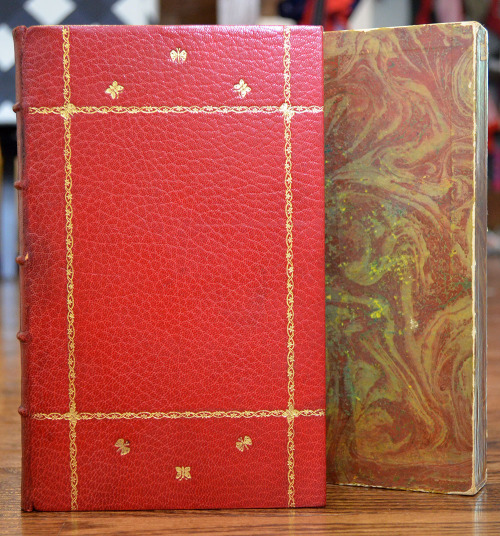
14) The Cupid: A Collection of Love Songs. Derby: Privately printed for subscribers only at The Moray Press, 1891. One of 100 copies on Van Gelder paper, numbered 57 to 156 (this copy numbered “155”), of a total of 444 copies. Bound in full red morocco by R.R. Donnelley & Sons (under the direction of Alfred de Sauty), with a unique design of two vertical and two horizontal rolls creating a large blank central panel, with the top and bottom middle panels decorated with a trio of butterflies (a features that shows up on several other Donnelley/de Sauty bindings of the period). Butterflies and gilt lettering to spine. Red marbled endpapers. Metallic marbled felt-lined slipcase. Measures 5.5" x 8.75". Fading to spine, as well as darkening and a closed crack to the upper half of the front hinge. Slipcase worn. Gift inscription to Anne and Elliott Donnelley from Mr. and Mrs. W.R. Rowes.
“For thirteen years [1923-1935], the Extra Bindery [at Donnelley] was headed by the distinguished English bookbinder Alfred de Sauty, who was recruited by T. E. Donnelley from the Central School of Arts and Crafts in London. De Sauty immediately set the standard for American bookbinding when he hired three European-trained bookbinders, William Anson, Basil Cronk, and Leonard Mounteney. As was the European tradition, hand-binding at RR Donnelley was a team effort. The head of the bindery generally established the design and specified the materials. From there, a book passed through the hands of several staff members, each responsible for a particular aspect of the process; sewing, backing, tooling, and finishing” (University of Chicago Library).
SOLD
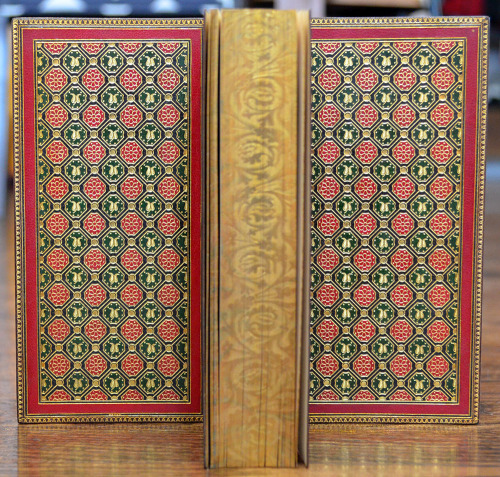
15) Paroissien Elzevir Rite Romain. Paris: Gruel et Engelmann, 1884. With 26 illustrations; 22 large black and white woodcut headpieces, as well as four chromolithographs plates highlighted in gold, along with many woodcut initials. Bound in full brown morocco by Gruel (stamp signed at the bottom of the spine and bottom of the front turn-in), with covers decorated in the style of Derome. Striking inlaid mosaic doublures, with a diapered pattern of inlays in green, blue, and red. Page edges marbled, gilded, and gauffered with a floral pattern. Headbands in red, green, and white. Burgundy silk flyleaves. Housed in burgundy leather and cloth slipcase, with fleece-lined leather and cloth covering. Measures approx. 3.25" x 6.25". The “jacket” and slipcase have done their job over the years; book is nearly spotless. Some wear to jacket and slipcase.
SOLD
Under the Hill Books
Owner: Nolan Goodman
Minneapolis, Minnesota
underthehillbooks@gmail.com
www.underthehillbooks.com / www.lorenzschwartz.com
